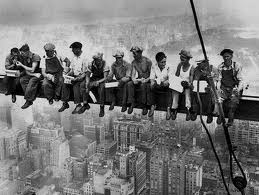
Workers
Since the general election I’ve been laying low, listening to people talk about the new administration and what President Donald J. Trump means to them.
Most supporters found a lot of what the president said and stands for to be objectionable, but voted for him because of the hope of jobs — a central campaign theme. Manufacturing jobs specifically. The kind with which I am very familiar.
On an issue page of the White House web page the administration laid it out:
Since the recession of 2008, American workers and businesses have suffered through the slowest economic recovery since World War II. The U.S. lost nearly 300,000 manufacturing jobs during this period, while the share of Americans in the work force plummeted to lows not seen since the 1970s, the national debt doubled, and middle class got smaller. To get the economy back on track, President Trump has outlined a bold plan to create 25 million new American jobs in the next decade and return to 4 percent annual economic growth.
As a deal-maker, 45 asserts he knows how to do it. His plan is not public so it’s impossible to evaluate it.
The metrics to evaluate 45’s proposal against what happens already exist in the Labor Department jobs report which shows the millions of jobs created during the Obama administration. Fill out the chart as time passes and new results are in, and there is an objective basis on which to evaluate performance. That is, assuming the methods of calculating jobs growth remains constant. A similar metric holds true for measuring economic growth. We should have a solid couple years in before the 2020 campaign begins. Thumbs up or thumbs down. It should be that simple.
I’ve worked several manufacturing jobs during my life and as a director of a logistics company that evaluated countless others. While living in Indiana I interviewed more than 10,000 people impacted by the exodus of jobs in the rust belt which produced what 45 described as the “American carnage” in his inaugural address. This is my turf, although it was in the Reagan administration, not during the Obama administration the web site references.
45’s discussion of bringing manufacturing jobs “back” is a bait and switch. Globalization of the manufacturing process and automation that includes robots doing repetitive tasks has eliminated many manufacturing jobs permanently. It will eliminate more.
Yes some went to Mexico. When Mexico got too expensive they went to China and other parts of Asia. Those jobs are gone and we can’t and don’t want to go back to manufacturing as it was.
Like it or not, with Wall Street occupying four key positions in the administration whatever jobs are created are likely to be similar to those under Obama.
Coal mining runs through my family tree.
It was unskilled labor required of the Industrial Revolution and whether my forbears had been in the United States a century before the American Revolution or had just arrived in the late 19th Century, cheap unskilled labor was needed to mine coal and men in our family did it.
Automation and changing methods of strip mining significantly reduced the number of workers required. Those jobs aren’t coming back either, especially as the cost of renewable energy continues to reach grid parity with coal, and countries like China realize the growth of coal powered electricity generation is making its people sick and look to other electricity generation means. Demand for coal is expected to wane.
I am not hopeful for resurgence in manufacturing jobs, nor was this my issue. However, 45’s posture on jobs came from the lips of every Trump voter with whom I spoke, no exceptions.
If Democrats hope to win the next presidential election we need to understand why friends, neighbors and work colleagues voted for 45. In part, it was about jobs I don’t believe will be back the way we knew them.


